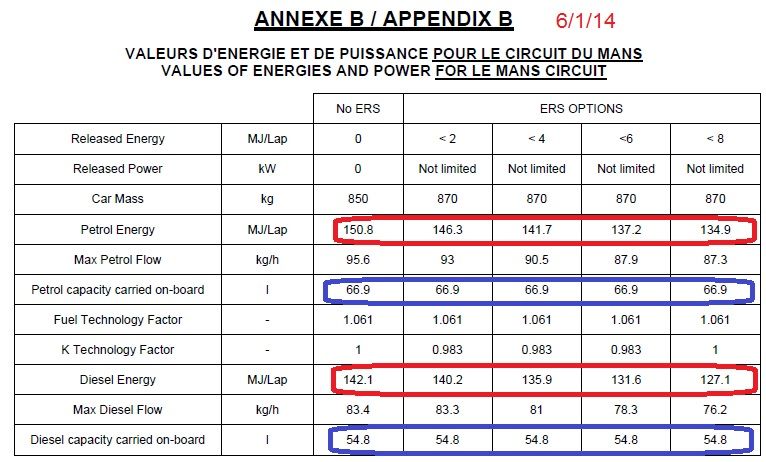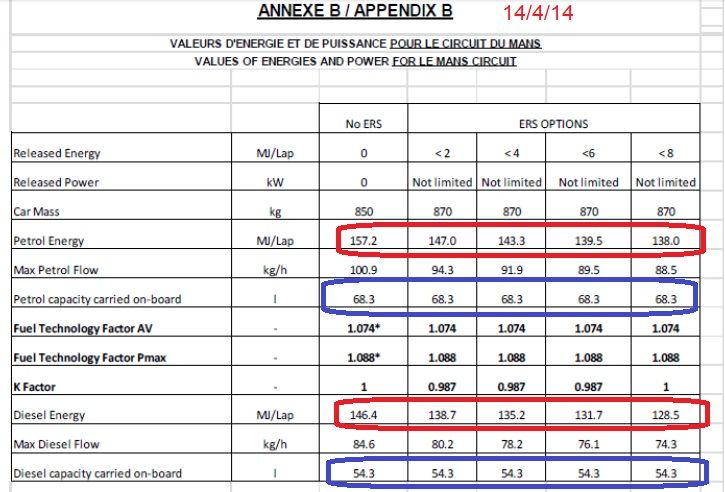So when you come to Le Mans you would use your most efficient mapping which will not give you more power but will give you 20% more laps. Perhaps that example explains my thinking.
You simply can't do this..... "more efficient mapping" would means a higher BSFC.... and the following are all directly fixed by the FIA:
1, BSFC (after declaration from the manufacturers)
2, fuel flow rate (calculated using the BSFC declared by the manufacturers)
3, Fuel flow per lap (calculated using the BSFC declared by the manufacturers)
4, Fueltank capacity (calculated using the BSFC declared by the manufacturers)
This also means the following are indirectly fixed,
and equalised amongst the best diesel and petrol competitors (
runnning in the same Hybrid category):-
5, The maximum instantaneous Power output of the engine (using BSFC and an instantaneous fuel flow rate)
6, The maximum Per lap Kinetic Energy available (using BSFC and the per lap fuel usage)
7, The maximum average power output during a lap (using BSFC and the per lap fuel usage)
8, The maximum Kinetic Energy available from the fuel between pit-stops (using BSFC and Fuel capacity limit)
9, The maximum number of laps completed whilst running at the maximum average power output (using fuel capacity, fuel flow rate per lap and BSFC).
But lets go through this step by step....
You're Audi and you secretly test and achieve a BSFC of 0.2 kilograms of fuel per hour per BHP produced over the hour. (number plucked out of mid-air)
You down-tune your engine and declare to the FIA that you can only achieve a BSFC of 0.230 (higher is worse, i.e. less efficient).
Your opponents have a petrol engine, but lets assume that they have identical aerodynamics and chassis performance. Can you use your engine's ability to run at a higher efficiency than you declared to gain longer or faster stints between pitstops...?
In order to equalise your power output (and hence Kinetic energy available over a specified time) compared to the petrol car the FIA tell you
your fuel flow rate cannot be more than 120kg per hour and you must not go over the declared BSFC. This limits you to a maximum power output of 522bhp (120/0.23 = 522). You cannot have more power than this since to do that you either need to use more fuel (and hence will break your fuel flow limit) or have a better BSFC (and hence break your BSFC limit imposed on you by the FIA); even though your engine
could achieve better BSFC or fuel consumption, you aren't allowed to use it because of the constant monitoring by the FIA.
In order to equalise your energy output over a lap (and hence average power over that lap) compared to the other cars the FIA tell you
your fuel flow rate cannot be more than 6kg per lap and you must not go over the declared BSFC. Assuming a 4 minute lap this limits you to an average power output of 391bhp ((60/4)*6/0.23 = 391bhp), which is an energy of 391 x 0.7457 x 60 x 4 = 70MJ. You cannot have more energy than this since to do that you either need to use more fuel (and hence will break your fuel flow limit) or have a better BSFC (and hence break your BSFC limit imposed on you by the FIA); even though your engine
could achieve better BSFC or fuel consumption, you aren't allowed to use it because of the constant monitoring by the FIA. You could use less energy of course (either by using less fuel or running at a lower efficiency), but then you'll simply go slower than your opponents who are using all their energy.
In order to equalise the stint length the FIA tell you that
your fuel capacity cannot be more than 80kg. in order to be competitive with your opponents you will need to use all 80kg of fuel, and you will need to use it at the highest allowable efficiency figure (the declared value of 0.230) to achieve the highest possible kinetic energy output (since fuel used x time / BSFC = kinetic energy). You could burn fuel at a lower rate, but you can only do so at the declared BSFC limit, so you are simply trading a lower average BHP for more laps, but that means you'll be slower over those laps (since your average BHP is less which is less kinetic energy per lap) than your competitor, who, through the EoT process has exactly the same amount of Kinetic Energy (and hence power) available over a single lap, and between pit stops.
You can see that there is no way to use your engine's ability to be more efficient than the figure you declared, and the only strategy available to you is to trade average BHP with the number of laps between refuelling stops. But this will make you slower over those laps than your opponents.
Now remember, the amount of Hybridisation is
not taken into account in the fuel capacity calculations.... so more Hybrid energy = more kinetic energy between pitstops. But Hybridisation IS taken into account in the per lap fuel allowance.... so you can't use the hybrid power to go faster, but you can use it to go further.... The only reason for going for a smaller Hybrid class is:-
1, You cannot build a Hybrid system light enough to meet the minimum weight limit.
2, Fitting the hybrid system has some other detrimental affect on the car (aerodynamics, CG height, balance, reliability etc).




